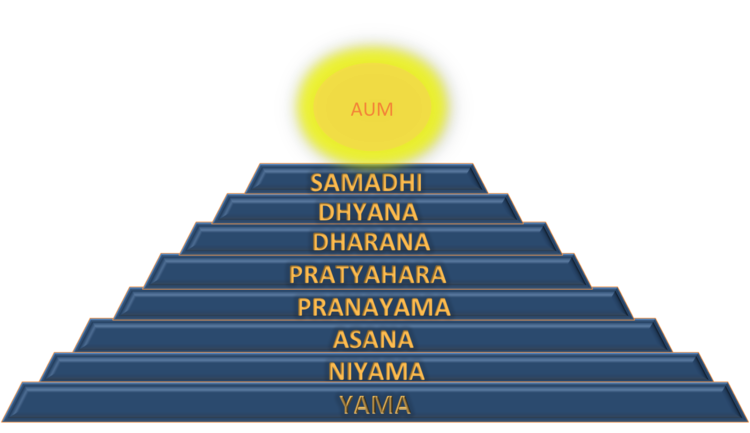Yoga Bharati - Our Philosophy
What is Yoga?
Developed by the ancient Hindu sages in the Indian subcontinent, yoga is a psycho-somatic discipline with its roots going back over 5,000 years. The word “yoga” means “union” and hints at the final goal of yoga practice–to be in union with one's true nature or Atman at every level of existence. The atman, or one’s true nature, is a fragment of the all-pervasive Spirit or Brahman. This goal is to be achieved by following practices developed as a part of an integrated and holistic system for health and human wellness.
Today, most of the yoga practice in the West focuses on physical postures called Asanas. However, yoga has much deeper applications and helps to promote health and happiness from the individual (Vyashti) to the societal level (Samashti). It is a complete system of suggested practices based on an individual's native personality (Prakriti), inclinations (Vasanas), and lifestyle. Indeed, the deeper one delves into the study of yoga, the more one uncovers the flexibility and richness of its traditions in achieving complete wellness.
Ashtanga Yoga - The Eight Limbs
At Yoga Bharati, we follow the particular principles of practice established by Sage Patanjali, a brilliant thinker and author who lived around 250 BCE, and Swami Vivekananda, a man of great magnetism who worked both in India and America during the late part of the 19th century.
Patanjali, the father of yoga, suggested that the practice of yoga be conducted in eight limbs-- popularly known as Ashtanga Yoga. Ashtanga Yoga gives a comprehensive and systematic approach to developing the mind. This approach includes Yama (guidelines for ethical relationships), Niyama (guidelines for ethical personal living), Asana (postures), Pranayama (controlled and deliberate breathing patterns), Prathyahara (withdrawal of mind from distractions), Dhyana (focus of the mind upon goal), dharana (the expansion of focused mind into everyday life) and samadhi (an establishment of balance and harmony in living). Through the practice of these principles, one may experience yoga--a connection with our true self.
Yoga As Medicine
At Yoga Bharati, we believe yoga is a complete holistic practice for self-growth and self-transformation. Yoga has been shown to improve quality of life and can accelerate the healing of chronic conditions resulting from modern lifestyles and stress. Read our white paper on issue publication below to read our yogic concepts at a high level:
Yogic Concept of Disease and Stress
The fundamental Yogic belief is that disease is a disturbance in the naturally healthy and well-functioning human mechanism. These disturbances occur at five levels of human existence--also known as the Pancha Kosha:
1. The physical sheath (annamaya kosha)– body with its visible parts such as the skeletal, muscular, glandular systems
2. The vital energy sheath (pranamaya kosha) - constitutes prana responsible for all physiology
3. The mind sheath (manomaya kosha): which carries on the functions of perception, memory and emotions
4. The intellect sheath (vijyanamaya kosha) - that which discriminates the right from the wrong and helps us make right choices.
5. A state of awareness (anadamaya kosha): a state of existence that is free from thoughts and emotions
By removing disturbances at these 5 levels, one is able to return to one’s true, natural state of being and be a healthy, radiant, peaceful, joyful and loving person.
Stress and Sympathetic Hyper-Arousal
The ancient yogic text Yoga Vasistha states that most of the ailments are psychosomatic in nature (adhija).This view is mirrored in the modern understanding of disease, with stress being cited as a hugely contributing factor in most non-communicable diseases.
Stress may be defined as the psychological and physiological response one has to an overwhelming situation either real or imagined. Over the course of evolution, our bodies have developed an effective way to react to dangerous or threatening stimuli. Our stress response is controlled by our nervous system. The increase in stress (fight-or-flight) —Sympathetic Response is ideally followed by relaxation (rest-and-digest) — Para-sympathetic System. Historically, the stress response was supposed to be a spike in stress levels in response to a threatening situation (eg. seeing a tiger), followed by action (eg. running away and finding safety), and finally ending in relaxation.
However, the nature of the threatening stimuli has changed dramatically in modern life. We now worry about upcoming exams, or deadlines or relationships rather than lions and tigers. Since these are ubiquitous and never-ending part of life, we are unable to relax our systems completely. Thus, repeated and prolonged sympathetic tone of the body causes stress related ailments.
Stress manifests initially as psychological problems such as irritability, excessive smoking or alcohol, sleep disturbances, etc. Over the years it shows up in irregular breathing patterns, digestive problems, generalized tiredness, body aches, inflammation and muscle spasms, exhaustion and immune disturbances. If left untreated it could result in autoimmune diseases (such as arthritis) or lead to diabetes or cardiovascular disease.
Yoga as the Solution
Any form of relaxation can increase the rest-and-digest aspect of our physiology. Yoga provides a wakeful state of relaxation and hence increases parasympathetic response much more effectively than sleep and other passive forms of relaxation. Research has shown that wakeful state of relaxation such as Cyclic Meditation practice significantly reduces oxygen consumption and energy expenditure to a greater degree (32.1%) than a comparable period of supine rest [Int J Yoga. 2009 Jul-Dec; 2(2): 46–48.]
Using alternatively stimulating and relaxing postures to release stress in the body.
Using controlled and intentional breathing (pranayama ) slows down the rate of thoughts (lowering stress level) and allows one to become the master of one's mind. Stress occurs as a result of thoughts about the past and the future; Yoga frees us from worrying about what has already happened and the anxiety about what is about to happen. Staying focused on the present moment frees one from stress.
Once you are free of stress, you have the full freedom to act as you see fit rather than acting impulsively. Then healing happens naturally! This is Yoga Therapy.



